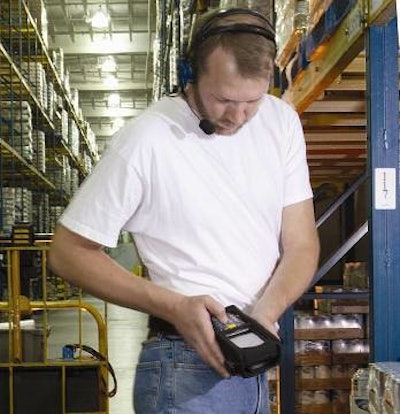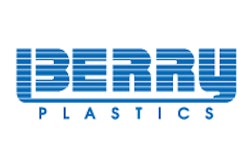
Vocollect is a major player in voice-directed Warehouse Management
systems in which workers, using wearable computers, are directed by
voice commands from a computer for their daily tasks. Now the company
is looking at bringing RFID into its voice capability. The following is
extracted from an interview last month with Tom Kerr, Vocollect's
director of applied research.
PW: Can you provide a summary of what your voice technology does alone, apart from RFID?
Kerr: It's a technology that’s been around for 20 years and is now mainstream in the supply chain and the market segments in which we’re involved. Voice is very good at directing work and directing tasks, and improves productivity and accuracy compared to manual means.
Workers using voice have wearable computers. Instead of using a keypad or a display to interact, workers put on a headset and respond to voice commands to interact with the mobile computer. These generally have a wireless link to a host system, the company's Information Technology infrastructure.
PW: RFID is another new technology that you're layering into voice?
Kerr: Yes. We’ve been working with RFID from an R&D perspective, since about 2003. In the supply chain, RFID is still considered an emerging technology.
PW: How does RFID fit in?
Kerr: RFID is a complementary technology with Vocollect voice. Voice is great at directing tasks, but it's not so good at direct verification. RFID brings that direct verification capability to the table and the additional benefit is that RFID does not need line of sight to the tags. That makes it, like voice, another hands-free technology. If you can combine voice and RFID then you can perform direct verification. We’ve developed a concept of the "talking tag," where the information contained in the tag is converted to verbal commands to help companies direct work at the specific object level if necessary.
PW: What does that mean?
Kerr: Without voice, I have to trust that the worker is where he says he is. It’s an indirect verification step. With voice, I can direct a worker to a specific location to perform a task and confirm it.
Consider RFID tags at the locations or on the cases or on the items that he or she is working and with wearable RFID readers that integrate with the mobile voice computer. That moves verification directly where the point of work or 'business event' occurs. Now you can confirm that a worker is at a specific location if they're doing order selection, or receiving, or storage,
Users can also verify the objects that they're working with by reading their tags and confirming that they're working with the right containers.
This also means finding and correcting mistakes or exceptions at the source, which is the least expensive place in the supply chain to do that. For regulated industries such as pharmaceuticals, you can perform the authentication step there as well.
Users may also gain a higher degree of accuracy building pallets as directed by the voice-RFID system. Your accuracy might be higher by picking each case individually rather than trying to read the whole pallet at once.
PW: Does Vocollect provide the wearable RFID readers?
Kerr: It's an R&D effort that we’re undertaking. We don’t have anything commercially available yet, but we are developing wearable products for a number of different form factors. Our approach has been two-fold:
1. Develop the technology and build prototypes, and
2. Look for specific applications where it might be useful and use those specific applications to help define what will eventually become the commercial product.
Other vendors are also working on wearable RFID. Those should be available either this year or in 2008. This is Electronic Product Code Class 1 Gen 2 technology.
PW: What's next?
Kerr: Voice with RFID will target applications where there is a return-on-investment. We’re looking to identify those applications with customers and prospects, and then we’ll use that to commercialize the product. We'll then move into other adjacent market segments as well. Companies involved in pharmaceutical products and mass merchandise retailers are interested in voice-directed RFID.
PW: Where's the most promising starting point for this?
Kerr: In areas outside an RFID mandate. That will help gain adoption of RFID, and will also help spread the adoption of voice as well.
Those include both current voice customers and other companies that haven’t worked with either voice or RFID.
PW: Can you provide a summary of what your voice technology does alone, apart from RFID?
Kerr: It's a technology that’s been around for 20 years and is now mainstream in the supply chain and the market segments in which we’re involved. Voice is very good at directing work and directing tasks, and improves productivity and accuracy compared to manual means.
Workers using voice have wearable computers. Instead of using a keypad or a display to interact, workers put on a headset and respond to voice commands to interact with the mobile computer. These generally have a wireless link to a host system, the company's Information Technology infrastructure.
PW: RFID is another new technology that you're layering into voice?
Kerr: Yes. We’ve been working with RFID from an R&D perspective, since about 2003. In the supply chain, RFID is still considered an emerging technology.
PW: How does RFID fit in?
Kerr: RFID is a complementary technology with Vocollect voice. Voice is great at directing tasks, but it's not so good at direct verification. RFID brings that direct verification capability to the table and the additional benefit is that RFID does not need line of sight to the tags. That makes it, like voice, another hands-free technology. If you can combine voice and RFID then you can perform direct verification. We’ve developed a concept of the "talking tag," where the information contained in the tag is converted to verbal commands to help companies direct work at the specific object level if necessary.
PW: What does that mean?
Kerr: Without voice, I have to trust that the worker is where he says he is. It’s an indirect verification step. With voice, I can direct a worker to a specific location to perform a task and confirm it.
Consider RFID tags at the locations or on the cases or on the items that he or she is working and with wearable RFID readers that integrate with the mobile voice computer. That moves verification directly where the point of work or 'business event' occurs. Now you can confirm that a worker is at a specific location if they're doing order selection, or receiving, or storage,
Users can also verify the objects that they're working with by reading their tags and confirming that they're working with the right containers.
This also means finding and correcting mistakes or exceptions at the source, which is the least expensive place in the supply chain to do that. For regulated industries such as pharmaceuticals, you can perform the authentication step there as well.
Users may also gain a higher degree of accuracy building pallets as directed by the voice-RFID system. Your accuracy might be higher by picking each case individually rather than trying to read the whole pallet at once.
PW: Does Vocollect provide the wearable RFID readers?
Kerr: It's an R&D effort that we’re undertaking. We don’t have anything commercially available yet, but we are developing wearable products for a number of different form factors. Our approach has been two-fold:
1. Develop the technology and build prototypes, and
2. Look for specific applications where it might be useful and use those specific applications to help define what will eventually become the commercial product.
Other vendors are also working on wearable RFID. Those should be available either this year or in 2008. This is Electronic Product Code Class 1 Gen 2 technology.
PW: What's next?
Kerr: Voice with RFID will target applications where there is a return-on-investment. We’re looking to identify those applications with customers and prospects, and then we’ll use that to commercialize the product. We'll then move into other adjacent market segments as well. Companies involved in pharmaceutical products and mass merchandise retailers are interested in voice-directed RFID.
PW: Where's the most promising starting point for this?
Kerr: In areas outside an RFID mandate. That will help gain adoption of RFID, and will also help spread the adoption of voice as well.
Those include both current voice customers and other companies that haven’t worked with either voice or RFID.
Companies in this article






















